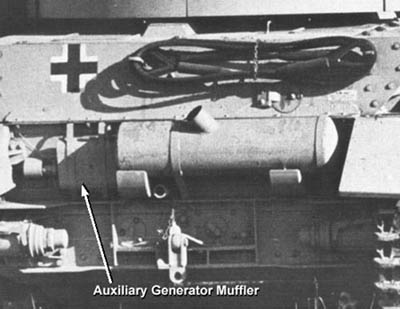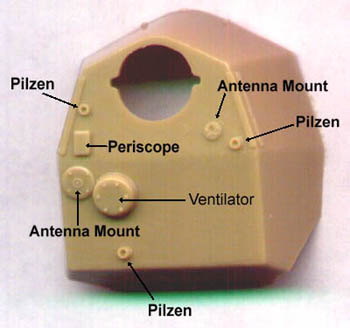| So
what version is it, exactly? I have seen this kit variously marketed as a Panzer IV Ausf. G, Panzer IV Ausf. H, and simply just as a Panzer IV. Turns out that the last name is the most accurate, considering that as the kit comes, it builds into no single, specific version of this famous, and important, tank. (Note: as far as I know, all of the ESCI Panzer IV kits are identical, regardless of their labels.) There are several specific details that differ from version to version of the Panzer IV. Many of these detail changes were introduced throughout the production run of the tank, so that no single version can be said to consist of a combination of "such and such" details. However, there were several major design changes that occured, which characterize certain versions. I have set up a table below to catalog certain key details, and match them with the versions of the Panzer IV on which they were seen. I have split the major versions (G, H and J) into "Early" and "Late" variants, because some of the details changed during their production runs. At the bottom of the table I have listed the ESCI Panzer IV kit, and which details are included with the kit.
So, as you can see from the above data, this kit is a mish-mash of versions. Many of the details in question can be scratch-built, or removed, as desired. But there are a few that are key to certain versions. For example, the gun. The L/48 was 18 inches longer than the L/43. Although the kit closely resembles the Late Ausf. J in many details, the kit comes with an L/43 cannon which poses a major problem for building any version after the Ausf. G. In order to build a Late Ausf. J, we would need to lengthen the gun, remove a return roller (reposition the others), find a late style sprocket wheel, and also change the exhaust style to the flame-dampener (flammentoeter) type (not shown on table).
There are some additional considerations as well. First of all, the bogie wheels. There were two styles of wheel hubcaps seen on the versions we are considering: the early version, and the late "forged" version, which appeared with the Ausf. H. It appears that the kit includes the forged version, but at this small scale, it really is difficult to tell, and they could pass for either type. The return rollers were changed to steel with the Late Ausf. H version, but the return rollers on the kit are so poor, that they could pass for anything, if painted right. Also, there should be a vision port on the turret front, to the left of the gun mantle, for the gunner. This port was present on all versions, but it is not included in the kit. Another consideration is the radio antenna. The location of the antenna mount varied with the vehicle version, but no mount is included with the kit, so I guess that its location is a moot point.
As one can see in the accompanying scan, there are several items on the roof, in addition to the Ventilator. The pilze (which were used to mount a crane assembly) became standard features in the late-war examples of all versions. But the antenna mounts and the periscope cover will need to be removed depending on the version one wishes to build. To build the early models of any of the above versions, you must scrape off everything but the ventilator. For the late versions, leave on the pilze and ventilator, get rid of the rest. Note that the Late Ausf. J had a port for the close-defense weapon on the roof, in the same location as the antenna mount next to the ventilator (actually, both the antenna mount and the close defense weapon port were tucked a little underneath the ventilator cover, with a notch taken out of the cover). With a little work, the antenna mount could be made to pass as this weapon port. So, in conclusion, we can see that it will take a little bit of work in order to build an accurate Panzer IV of any version out of this kit. Of course, we now have the alternative of building the "new" Hasegawa Panzer IV instead. I don't want this article to be a review of that other kit, so just suffice it to say that overall, it is pretty decent. Is it an accurate Ausf. G? Yes. Is it superior to the ESCI kit? With the exception of it's chassis and tracks, yes. In those areas, the ESCI kit is far superior. |
 So,
what if we stick with the L/43 versions, i.e., the Ausf.
G's? The kit closely resembles a late Ausf. G. To build
one of these, we would have to add vision/pistol ports to
the turret side hatches, and also add the auxiliary
generator muffler onto the rear hull. For the Early G, we
would need to change the commander's cupola hatch, add
vision/pistol ports to the turret side hatches, vision
ports to the turret sides, and add the auxiliary
generator muffler onto the rear hull. So it would seem
that the kit most closely resembles the Late Ausf. G. But
wait ...
So,
what if we stick with the L/43 versions, i.e., the Ausf.
G's? The kit closely resembles a late Ausf. G. To build
one of these, we would have to add vision/pistol ports to
the turret side hatches, and also add the auxiliary
generator muffler onto the rear hull. For the Early G, we
would need to change the commander's cupola hatch, add
vision/pistol ports to the turret side hatches, vision
ports to the turret sides, and add the auxiliary
generator muffler onto the rear hull. So it would seem
that the kit most closely resembles the Late Ausf. G. But
wait ... Finally, we are left with the biggest
mystery of all: the turret roof. It took me a long time
to find a turret roof that matched the kit part. None of
the scale plans I have show anything on the turret roof,
except a single ventilator cover, yet the ESCI roof has a
whole bunch of unusual stuff up there. I finally came
across a drawing and photo that explains all those little
mystery items on the roof, in Jentz's Panzer Tracts
No. 4 - Panzerkampfwagen IV. This roof belongs to
the Panzerbefehlswagen IV, the command version of this
tank. In order to build one of these, we would have to
make the same changes described above for the Late Ausf.
J, as well as add a couple of more antenna mounts at
various locations around the hull.
Finally, we are left with the biggest
mystery of all: the turret roof. It took me a long time
to find a turret roof that matched the kit part. None of
the scale plans I have show anything on the turret roof,
except a single ventilator cover, yet the ESCI roof has a
whole bunch of unusual stuff up there. I finally came
across a drawing and photo that explains all those little
mystery items on the roof, in Jentz's Panzer Tracts
No. 4 - Panzerkampfwagen IV. This roof belongs to
the Panzerbefehlswagen IV, the command version of this
tank. In order to build one of these, we would have to
make the same changes described above for the Late Ausf.
J, as well as add a couple of more antenna mounts at
various locations around the hull.